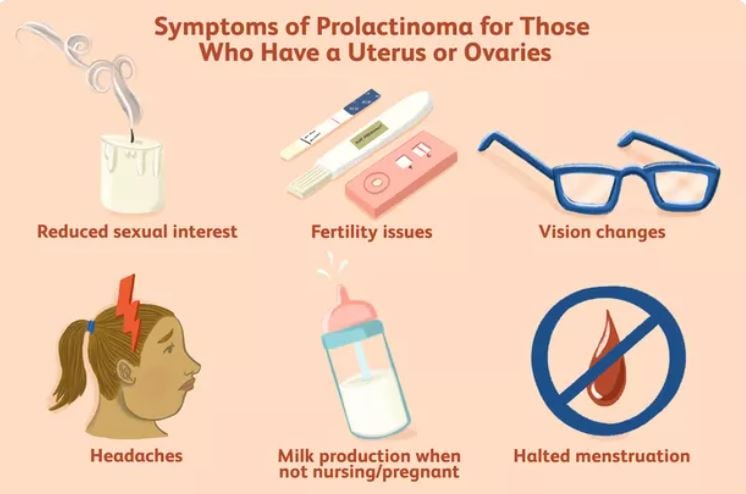Prolactinoma
Prolactinoma is an abnormal growth and common type of hormone-producing pituitary gland tumor. The tumor causes the pituitary gland to produce too much prolactin, resulting in hyperprolactinemia. Prolactinoma is almost always benign, which means it is non-cancerous. Read More
Top Doctors For Prolactinoma Treatments
Top Hospitals For Prolactinoma Treatments
Prolactinoma
Table of contents
What is prolactinoma?
Prolactinoma is an abnormal growth and common type of hormone-producing pituitary gland tumor. The tumor causes the pituitary gland to produce too much prolactin, resulting in hyperprolactinemia. Prolactinoma is almost always benign, which means it is non-cancerous.
Note:- Prolactin is a hormone secreted by the anterior pituitary gland. It ensures lactation after childbirth. It promotes the filling of the mammary gland with milk, and oxytocin is responsible for milk release. Prolactin is responsible for slowing down the menstrual cycle by increasing the duration of the corpus luteum.
The pituitary gland is a small size gland located at the base of the brain behind the bridge of the nose and below the optic nerves. It produces prolactin hormones. In women, normal prolactin levels are usually less than 25 ng/ml, and in men, less than 17 ng/ml.

What is the classification of prolactinomas?
The classification depends on how much the prolactinomas have increased concerning the sella turcica. There are two types of prolactinomas:
- Intrasellar micro-prolactinoma (microadenomas): less than 1 cm in diameter, not exceeding the size of the Turkish saddle
- Extrasellar macro-prolactinoma (macroadenomas): measuring more than 1 cm in diameter and exceeding the size of the sella turcica
Causes
Several conditions cause prolactinoma, but the reason behind the development of the tumor is unknown.
The potential cause can be:
- Traumatic brain injury
- Brain inflammation (due to bacterial or viral infection)
- Complications associated with granulomatous and infiltrative processes
- Metabolic disorders (linked with irreversible change or replacement of normal liver tissue with connective tissue)
- Chronic renal failure
Other conditions that cause a high level of prolactin are:-
- Prolactin-secreting adenomas
- Medications
- Stress
- Pregnancy
- Hypothyroidism
- Kidney disease
- Chest injury
Symptoms
Prolactinoma symptoms depend on the effect of high prolactin on the reproductive system and tumor size. A large tumor can put pressure on the optic nerves or nearby brain tissue, leading to headaches or vision problems. So, the larger the prolactinoma, the more symptoms it will show.
Symptoms in women

- High prolactin levels produced by the tumor affect the ovarian ability to produce estrogen. When estrogen levels are low, women have irregular or no menstrual periods, low sex drive, vaginal dryness, and difficulty in getting pregnant.
- Due to the effect of elevated lactotroph hormone levels on breast tissue, women who are not pregnant or breastfeeding often experience milk discharge from their breasts. This condition is called galactorrhea.
- Prolactinomas in women are small and mostly do not grow in size, because of which headaches, visual symptoms, or other signs related to the tumor are rare.
Symptoms in men
- Even a small increase in prolactin levels in small pituitary tumors can lead to a decrease in libido and cause erectile dysfunction. Large tumors in men are associated with very high levels of prolactin, which almost always causes sexual dysfunction. Discharge from the chest (galactorrhea) can occur in men but are much less common than in women.
- Men with prolactinomas may also see a doctor for headaches or vision problems due to large tumors that can put pressure on the optic nerves. Due to the size of these tumors, lactotroph hormone levels are often very high. High prolactin levels can limit the testes’ ability to produce testosterone and can often cause infertility.
How is prolactinoma diagnosed?
- As a first step, the doctor will take a blood sample to understand the prolactin level. The average prolactin level is less than 25 ng/ml in women and less than 17 ng/ml in men. If the prolactin level is slightly elevated, then the patient may need to repeat the test because even the stress and discomfort blood draw can affect the results. During the tests, the doctor will look for conditions other than prolactinoma that may increase prolactin levels and may take additional blood samples to check different hormone levels.
- The next step is to examine the pituitary gland using magnetic resonance imaging (MRI) with and without contrast. An MRI of the brain will show if there is a tumor on the pituitary gland, its size, and whether it has affected the optic nerves or other areas around the pituitary gland.
- Doctors use different terms to describe a tumor based on its size. Prolactinomas are microadenomas if they are less than 10 mm (about ½ inch) and macroadenomas if they are 10 mm or more.
- Most prolactinomas in women are microadenomas. Prolactinomas in men are more likely to be macroadenomas, but not always. Large tumors are sometimes associated with high prolactin levels (more than 1000 ng/ml).
- Macroadenomas can affect optic nerves, and men or women with large tumors may need an eye examination as part of their initial assessment.
How is prolactinoma treated?
Treatment of prolactinoma aims to reduce the level of prolactin to normal. An endocrinologist treats prolactinoma and may prescribe the most effective dopamine receptor agonists. These drugs act as dopamine to control prolactin secretion. In both women and men, the goal of pharmacotherapy is to normalize prolactin levels, restore sexual function and fertility, and reduce tumor size. The two drugs commonly used and approved for the treatment of hyperprolactinemia are Parlodel (Bromocriptine) and Dostinex (Cabergoline). In addition to the approved medicines, there is a third drug, Norprolac (Quinagolide). All approved drugs are available in generic form and are effective in reducing prolactin levels and reducing tumor size in more than 90% of patients.
Prolactin levels usually return to normal within a few days, and tumor shrinkage usually appears 3-6 months after starting therapy. While both Bromocriptine and Cabergoline are effective, Cabergoline works slightly better at lowering prolactin levels and shrinking tumor size with fewer side effects. The disadvantage of Bromocriptine and Cabergoline is that discontinuation of it leads to tumor growth. It is not possible to predict which patients can safely stop taking the drug. If the patient is diagnosed with a microadenoma, then the doctor will likely recommend treatment for at least two years before considering reducing or discontinuing the treatment regimen. Even after treatment discontinuation, the doctor will need to monitor the patient’s prolactin level occasionally since the tumor may grow again. Successful long-term drug withdrawal may be possible in some patients, but patients with macroadenomas are likely to need drug therapy indefinitely. In general, surgery is not recommended as the primary therapy for prolactinomas because dopamine agonists are more effective, and surgery does not always cure the disease.
- Patients with microadenomas may need pituitary surgery if dopamine agonists do not work or if it leads to serious side effects.
- Patients with macroadenomas may require surgery if the tumor keeps growing despite drug therapy. The types of surgical approaches the surgeon uses to remove prolactinomas are listed below:
a) Transsphenoidal surgery- It is the most common surgery to treat prolactinoma. During this surgery, a small incision is made at the back of the nasal cavity or under the upper lip.
b) Transcranial surgery- The surgeon removes the tumor through an opening in the skull during this surgery.
The surgical outcome highly depends on the skill of the surgeon, and a neurosurgeon with extensive experience in transsphenoidal pituitary surgery should perform the surgery.
FAQ
For about 1 in 10,000 people, prolactinoma can develop with no known cause. Prolactinomas occur in both sexes but more commonly in women. The tumor is rare in children.
Doctors commonly prescribe Bromocriptine and Cabergoline since they do not cause severe complications.
Dopamine agonists cause side effects like nausea, low blood pressure, and dizziness. But the patient can avoid side effects by taking a lower dose and consuming it while sleeping or eating.
Small prolactinoma rarely grows in size, so treatment with Cabergoline or Bromocriptine is not always necessary to prevent tumor growth. However, it is critical to maintaining normal estrogen and testosterone levels in order to avoid low levels of sex steroids and prevent bone loss.
The doctor may recommend estrogen or testosterone treatment instead of dopamine agonists. Estrogen therapy for women and testosterone therapy for men is safe. During estrogen or testosterone therapy, the doctor will monitor the prolactin levels.
An increase in prolactinoma tumors usually leads to a significant increase in prolactin levels and causes symptoms. If signs and symptoms are severe, the patient may need to consult a doctor for diagnosis and treatment.
Once treated with prolactinoma, the patient may need to keep a close eye on their overall health and consult an endocrinologist once a year. The patient has to take a blood test twice a year to determine the level of prolactin to start treatment on time for the secondary development of the disease.
Small non-cancerous pituitary tumors (adenomas) are generally found more common in the population. Approximately 40% of pituitary tumor cases are prolactinomas, making it the most common type of pituitary tumor [1].
A prolactinoma can cause weight gain in certain cases when it’s associated with other pituitary hormone issues like hypothyroidism or increased cortisol production, which can cause weight gain.
References
https://my.clevelandclinic.org/health/diseases/22007-prolactinoma

























































